RPA/Transit Riders Alliance proposal to respond to the L Subway shutdown includes a dedicated transitway on 14th Street in Manhattan
New York City's L Line subway carries about 225,000 riders per day. It experienced severe damage because of Superstorm Sandy and the line will be closed for 18 months, beginning in 2019, for repair, rehabilitation, and overhaul ("L Train Will Shut Down From Manhattan to Brooklyn in '19 for 18 Months," New York Times).
Corridor management in terms of person throughput not motor vehicle throughput. Similar to how I suggested that Metrorail, NPS, DDOT, MARC, Maryland SHA, and others should have taken a broader "corridor management approach" to dealing with issues relating to I-270 capacity, shutdown of Beach Drive, and shutdowns of portions of the Metrorail Red Line ("Transportation network interruptions as an opportunity: Part 2" and "Transportation network service interruptions part 3: corridor/commute shed management for Northwest DC and Montgomery County, Maryland"), New York City's Regional Plan Association and the Rider's Alliance have joined together to create a community-centered corridor management approach to dealing with the shutdown of the L line.
-- Fixing the L Train and Managing the Shutdown
As to be expected of a report involving RPA, it is superb, with many many great recommendations, including repositioning 14th Street in Manhattan as a high capacity transitway to be used for high capacity replacement bus services, but also open to bikes and taxis, but closed to cars.
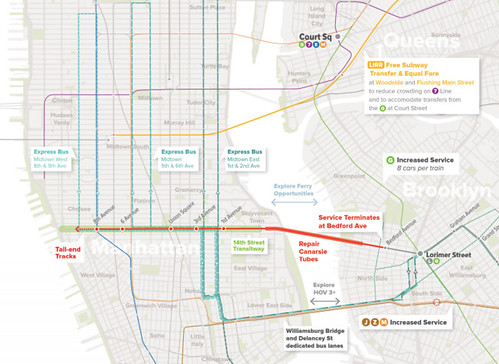
Image showing some of the recommendations from the report concerning the transitway proposal and complementary bus services.
Attempt to create a congestion pricing zone in Manhattan as a result of post-9/11 changes in traffic management. This reminds me a bit of how congestion was significantly eased in New York City when after 9/11, to reduce motor vehicle traffic in Manhattan, New York City instituted HOV-equivalent requirements for automobiles using the East River bridge and tunnel crossings south of 63rd Street--for rush hours, single passenger automobiles could not cross.
It had a couple of interesting effects. Traffic was shifted to times outside of rush hour, both before and between rush periods and to other bridges outside of the restriction zone, while traffic declined overall, but congestion on feeder roads was accentuated.)
-- EFFECTS OF CATASTROPHIC EVENTS ON TRANSPORTATION SYSTEM MANAGEMENT AND OPERATIONS: NEW YORK CITY- SEPTEMBER 11, US DOT
The experience and positive impact on congestion from the restrictions on Single Occupant Vehicle trips set the stage for creating a congestion charge system in New York City, which US DOT was willing to support and provide funding for, but the State Legislature prevented the city from going forward ("New York assembly shelves Manhattan congestion charge," Guardian).
.
It also set the stage for Sam Schwartz' more recent proposal to change how the bridges are tolled in order to ease congestion ("Plan to change New York City's bridge tolls, reduce traffic hits Albany," Crain's New York Business
L Train shutdown as a corridor management opportunity. The closure of the L train, even temporarily, if the city created a dedicated transitway in response, could be as significant a change to the city and to "North American best practice" as NYC's readjustment of road space between motor vehicle traffic and pedestrian and placemaking use, such as on Broadway Avenue and in Times Square, and the creation of dedicated cycle tracks on major roads. These highly visible actions helped to shape the vision and practice of transportation and planning departments elsewhere.
Reprioritizing road space towards pedestrians in New York City serves as a global example. The reprioritization of road space towards pedestrians in New York City has had a dramatic effect on urban design practice across North America. Along Broadway and around Times Square, the transportation department enacted a number of "tests", which later became permanent, shifting traffic lanes to pedestrian plazas, bike lanes and related uses.
Before and After, Times Square. NYC DOT photo.

Transitways and transit malls. Dedicated transit "malls" exist in a number of US cities, although they may vary in how much other traffic is allowed. The Nicolett Transit Mall in Minneapolis, the Bus Mall in Portland, Oregon, and the 16th Street Transit Mall in Denver are particularly prominent examples. Many European cities employ a variety of dedicated surface transit and pedestrian ways.
The Spitalerstrasse transitway, Hamburg, Germany, is open to cyclists and taxis.

Nicolett Transit Mall, Minneapolis

Replacing the capacity of the shut down high capacity L line subway service will be very difficult for New York City.
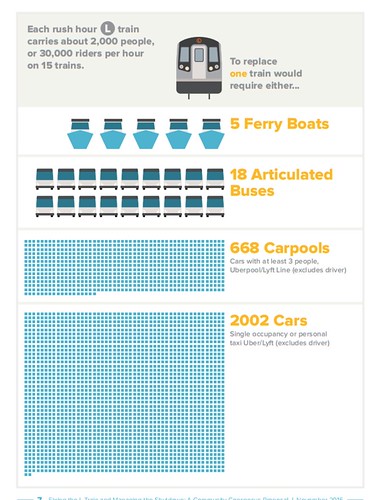
A highly visible transitway as a communication device for best practice in transit service. It is a struggle in many communities to create a dedicated transitway network for surface transit, especially buses (see "16th Street's traffic lights are now optimized for buses," Greater Greater Washington), and if NYC DOT is willing to create a dedicated transitway on 14th Street and if MTA responds with expanded and extended bus service--such as cross-borough high capacity bus services to stand in for the shut down subway--and complementary changes elsewhere, such as dedicated bus lanes on the Williamsburg Bridge to support cross-borough bus service, it could be equally transformative for sustainable mobility practice across the country.
Will MTA and NYC DOT implement these concepts? It will be interesting to see how NYC and MTA respond to the recommendations, which include other changes for the line and some of the stations to improve accessibility, access, circulation, capacity, and interlining, as well as marketing of commercial districts affected by the loss of high capacity transit service.
Some of the recommendations from the report
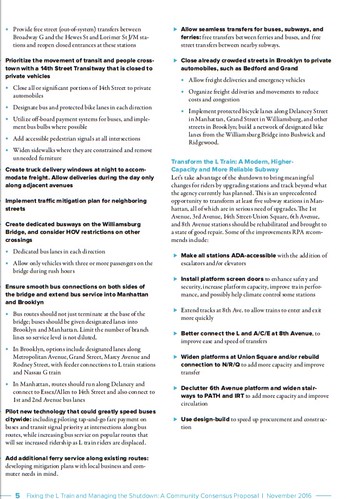
Two important ideas they overlooked: three-section buses and a free bus fare
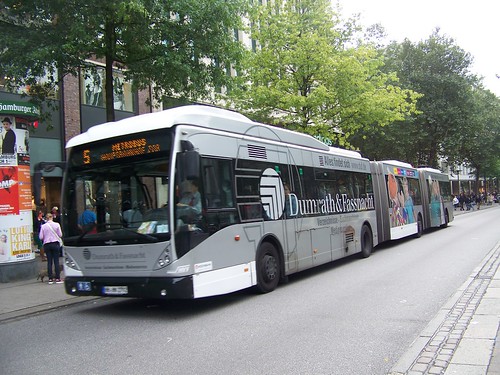
Bi-articulated bus on Spitalerstrasse transitway, Hamburg, Germany.
How about bi-articulated buses? While articulated buses are allowed for use on US streets, three-section bi-articulated buses are not authorized for use on the public roadway system--even though many states have authorized the use of similarly lengthy truck and trailer units on certain roads (most often Interstate Highways) that are about the same length as a triple-section bus.
Articulated buses are about 60 feet long, while bi-articulated buses are about 82 feet long. Depending on the seat configuration and the willingness to sit or stand very closely, bi-articulated buses can carry about 200 riders, while the capacity of an articulated bus is about 120 passengers.
Typical articulated bus, Metrobus, Washington, DC.
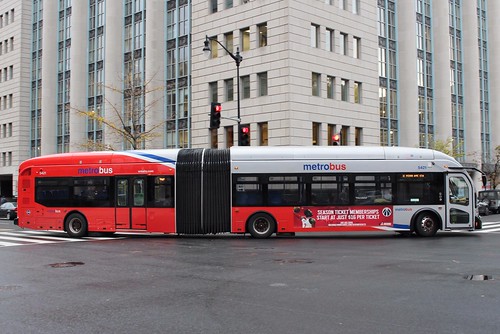
Triple trailer semi-truck (called Long Combination Vehicles or LCVs)

But why not allow New York City to use them for a special L train replacement bus service? This would increase rider capacity, reduce the number of buses needed to provide replacement service, provide incredible branding and marketing, and reduce the number of bus drivers needed to operate the service. Such buses are used on "regular roads" in many cities, although many cities like Curitiba and Bogota primarily use such buses on a dedicated transitway network not accessible to automobiles.
Aachen, Germany
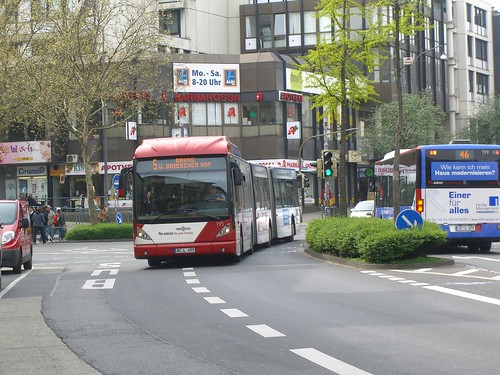
Luzern, Switzerland
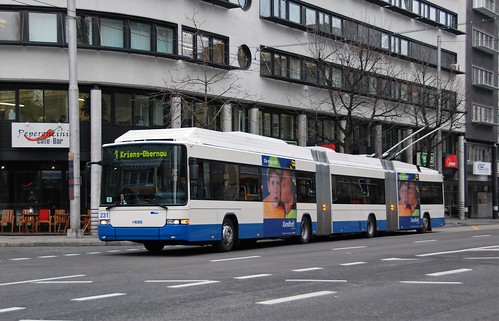
Consider free fare for the special cross-borough BRT service. For the special replacement high capacity bus service only, especially if a three-section bus could be used, providing free fares should be considered, which would significantly speed entry onto buses and reduce the amount of dwell time--the time the bus sits at a stop, while passengers exit the bus and enter and pay.
For various reasons, it's not possible to create the prepayment process and dedicated stations comparable to Curitiba's bus rapid transit system ("How Curitiba's BRT stations sparked a transport revolution," Guardian). From the article:
But high ridership created a problem. Buses in the system still used conventional boarding systems, where passengers entered through the front of the bus and paid fares on board. Lerner, who was back in office for his third term as mayor, came up with an elegant solution.But you can accomplish the same effect with free fares.
He called for a revamped station design that enabled faster boarding through multiple doors, and fares would be exchanged before entering the station – similar to subway or light-rail systems. Offboard payment would also allow for the creation of transfer stations, meaning one fare would cover the entire system. To top it off, Lerner gave the stations a distinctive look by placing them in futuristic glass tubes. These new “tube stations” debuted in October 1991 as part of the first Ligeirinho express line. Today there are 357 tube stations throughout the city.
With this important addition, the city’s system became the world’s first bus rapid transit (BRT) network.
Note that while the report does not propose free fares, it does propose free transfer between ferry and bus, which isn't the case now, as ferries are city provided services, while bus and subway services (which do provide free transfers between bus and subway for pass holders) are run by the State of New York.
Note that certain dedicated service bus service in both Minneapolis and on the 16th Street Transit Mall in Denver are free.

Minneapolis.
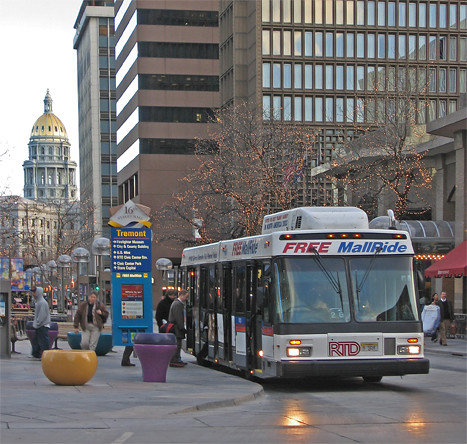
Denver.
But the current shutdown schedule can't accommodate the approval of bi-directional bus services, acquisition of buses, and identification of funding for such changes. Even though the shutdown is supposed to happen in 30 months, that's not enough time to acquire and receive hundreds of bi-articulated buses, and deal with how to store them, let alone getting FTA to approve their use in the city, to train drivers, etc. Plus you have to line up the money to acquire the buses and you have to figure out how to use them once the L train goes back into service.
And providing a free transit service wouldn't be cheap. But it would be temporary. And had Hillary Clinton become President, maybe the US DOT/FTA would have funded such a service in part, as a demonstration also, in concert with the demonstration and test of the efficacy of bi-articulated buses.
But their omission makes their consideration unlikely. By putting the ideas out there, they'd be out there. It'd be worth delaying the shutdown for a year or more if it were possible to use bi-articulated buses and have them be free in order to create and deliver the best possible replacement service, reducing inconvenience and problems as much as is possible.
And that, by the way, is the point of planning to begin with, to make things better and easier, not harder.
=====
WRT Metrorail and MARC and I-270, one element of corridor management that should be studied is bi-directional service on the MARC train line between DC and Montgomery County. Currently the service runs in only one direction, from West Virginia/Maryland in the morning to DC, and from DC to Maryland/West Virginia at night.
The opportunity for commuting is high between DC, White Flint, Rockville, and Gaithersburg more generally, but with subway shutdowns, riders could be shifted to the MARC railroad service, and this would help to market the service and create more demand for various service and integration improvements, including a common transit fare media system ("One big idea: Getting MARC and Metrorail to integrate fares, stations, and marketing systems, using London Overground as an example").
Labels: car culture and automobility, emergency management planning, sustainable mobility platform, transit marketing, transportation demand management, transportation planning, transportation system management



2 Comments:
The marginal capacity increase of a bi-articulated bus simply aren't worth the costs.
A transit agency like NYC MTA would need to likely build a completely new bus garage from scratch to accommodate a new type like this that cannot fit in existing garages and bus depots.
And that's assuming you could get over the financial and regulatory issues with getting a street-legal version approved, and then manufactured by a US-based, Buy America compliant manufacturer.
All of that is a tremendous hassle for a extraordinarily marginal increase in capacity. It's simply not worth it.
Good points. I do think it would be worth doing on a long term basis, if it were also an opportunity to create multiple transitways, and redeploy the buses to those transitway-specific routes.
But the storage element if anything is the biggest hurdle, let alone regulatory approval and the cost of acquisition.
So on that basis, you're definitely right, the capacity increase may not be worth it. Even with the reduced labor costs.
... although with "capacity" I'm not thinking just of the amount of passengers, but how many buses you need to have running up and down the street to replace the subway service.
This would reduce the number of buses significantly.
And that does have value.
So if this were used to jump start a complete reconfiguration of the bus route network towards high capacity and dedicated transitways, it could be worth doing.
Otherwise, not.
Post a Comment
<< Home